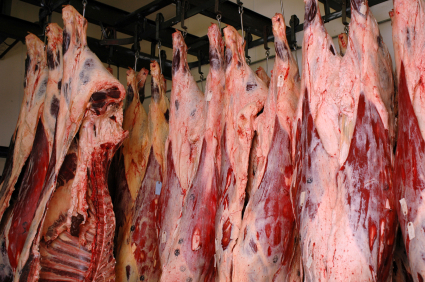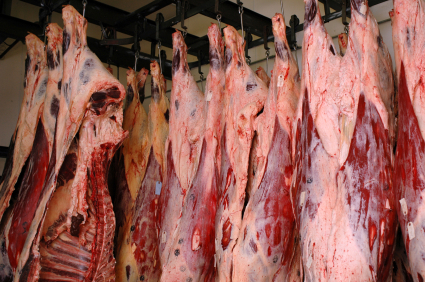 Side of E. coli with that burger?In Meat Wagon, we look at the latest outrages from the meat and livestock industries.
Side of E. coli with that burger?In Meat Wagon, we look at the latest outrages from the meat and livestock industries.
—————————–
As I reported Friday, a man with a Big Ag background has emerged as the frontrunner for a still-empty USDA post called “undersecretary of food safety.”
The holder of this position oversees the USDA’s Food Safety and Inspection Service, which has the nearly impossible task of ensuring that our gigantic, factory-scale slaughterhouses produce safe meat. (The USDA handles safety issues around meat; FDA oversees safety for all other foods.)
An excellent piece by Bill Tomson in Friday’s Wall Street Journal lays out how meat industry influence impedes the agency’s ability to keep deadly pathogens out of the meat supply. You read it thinking, gee, sure would be nice if Obama chose an independent, consumer-oriented person for this post, and not the industry hack he’s reportedly considering.
Tomson’s story focuses on a proposed rule change that’s been floating around the FSIS bureaucracy for over a year–one that would almost surely have prevented the recent E. coli O157:H7 outbreak related to meat from a massive JBS-Swift plant in Colorado.
As Tomson points out, the USDA currently only concerns itself with E. coli-tainted meat that’s immediately destined to be ground into hamburger, called the “trim.” The rationale is this: E. coli typically lies on the exterior of a cut of meat (it gets there through contact with E. coli-tainted shit from the cow’s gut). The pathogen can only penetrate the interior when the meat’s been ground up.
But the catch is, the trim isn’t the only part of a cow carcass that ends up as hamburger. Beef packers can sell what’s known as “primal cuts”–large chunks of beef that end up getting cut into steaks, etc.–to supermarket chains and the like, even if they’re known to be infected with E. coli. “Steaks and the whole cuts they come from aren’t considered dangerous to human health, or ‘adulterated,’ even if E. coli bacteria is present because, unlike ground beef, steaks don’t provide bacteria access into the meat below the surface,” writes Tomson. However …
…those whole cuts and other primal beef often get turned into ground beef even though that wasn’t the intended purpose of the meat, especially in summer months when grilling weather drives up consumer demand for hamburger meat.
And that hamburger meat can deliver the deadly E. coli O157 pathogen straight to the dinner table. That’s precisely what happened in the JBS recall. Back in April, the global-scale meat giant sent nearly half a million pounds of primal cuts known to be infected with E. coli O157 into the marketplace. After dozens of people nationwide fell ill with E. Coli poisoning from burger meat ground from those primal cuts, the company issued a “voluntary recall” (another gaping whole in our food-safety system is that federal agencies don’t have the power to recall tainted food,)
Weirdly, at least a little bit of most primal-cut beef ends up as burger, E. coli taint or no. Writes Tomson: “Another separate but related safety gap is a lack of government testing for E. coli in ‘bench trim,’ which is the leftover material once steaks and roasts and other cuts are produced from beef primals. That bench trim is often turned into ground beef.”
So, about year ago, the FSIS floated new rules that would have closed these gaps. Writes Tomson:
The USDA has been considering for more than a year a policy change that would allow whole beef cuts to be considered “adulterated” — and thus subject to recall — even if they aren’t “intended for use in ground beef,” according to Daniel Engeljohn, a deputy assistant administrator for USDA’s Food Safety and Inspection Service, or FSIS.
But that rule remains “under consideration,” even after the JBS disaster. Why hasn’t the agency moved to institute a new rule that would decrease an established threat to public health? Tomson suggests the answer lies in industry influence at USDA:
Representatives of the U.S. meat packing industry like the [American Meat Institute] have fought the USDA’s FSIS “tooth and nail” since officials there began talking about allowing whole beef cuts to be considered adulterated with E. coli and government testing for bench trim, according to Tony Corbo, the senior lobbyist for the nonprofit consumer organization Food & Water Watch.
How pathetic that the USDA has so far bowed to this pressure. Meanwhile, Obama is seriously considering putting a Big Ag man with a history of using a public position to push agribusiness interests in charge of FSIS.
Stressed-out chickens, tainted meat
The new FSIS director will also be confronting a pathogen less dangerous than E. coli O157, but also much more prevalent: Campylobacteriosis.
Campylobacteriosis is one of the most common food-borne illnesses. It infects about 2.4 million people per year in the U.S.. the CDC reckons. It’s usually highly unpleasant but not life-threatening. The CDC lists “diarrhea, cramping, abdominal pain, and fever” as common symptoms, adding “The diarrhea may be bloody and can be accompanied by nausea and vomiting.” Ouch. It usually clears up within a week, but in people with “compromised immune systems, Campylobacter occasionally spreads to the bloodstream and causes a serious life-threatening infection.”
Most campylobacteriosis cases can be tied to factory animal farms, according to a study by US and UK researchers published last year in Plos Genetics last year (summary here). More than half of cases come from CAFO-grown chicken, while more than a third came from feedlot beef, the researchers found.
And now a new study, this one by researchers at the University of Bristol, England, finds that the level of campylobacteriosis (and salmonella) found in chicken meat is directly related to the level of stress experienced by the birds.
According to a summary of the study on MeatProcess, the researchers found that the animals “released higher levels of hormone noradrenalin when under stress which actually helps Campylobacter and Salmonella grow and spread more quickly.” Moreover, “A further finding from the study said Campylobacter can interact with other organisms in the gut of food animals, making it even more invasive.”
Apparently, the relationship between stress and Campylobacter had already been established. According to MeatProcess, previous research had already fingered the incredibly stressful process of transporting chickens from factory farms to factory slaughter facilities, when they are packed tightly together in cages and trucked down the highway. In a previous study, transport had been shown to cause “up to a tenfold increase in terms of Campylobacter concentration in the guts of animals and a doubling of the numbers infected,” the news service reports.
If the FSIS looks to fight campylobacter at all, it will likely be in the form of some novel anti-bacterial agent. This research points in a different direction: stop letting factory farms hold animals under highly stressful conditions.


